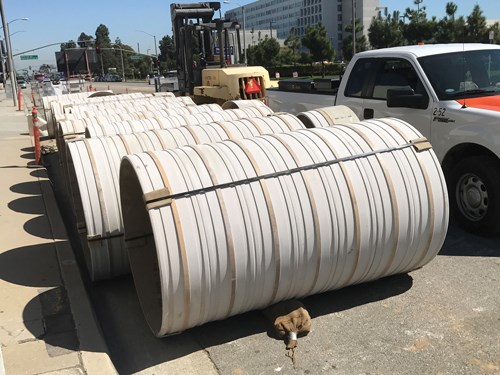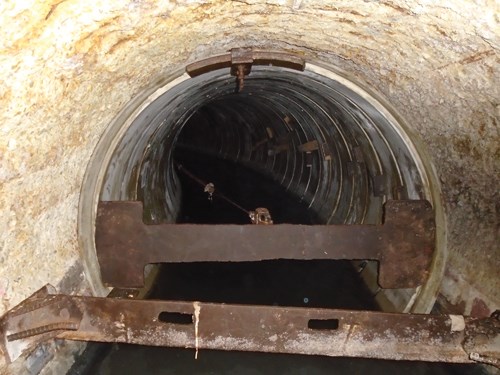April 2019 Vol. 74 No. 4
Rehab Technology
Unusual Sliplining Solutions Developed on Los Angeles Project
Jeff Griffin | Senior Editor
Rehabilitating or replacing large-diameter sewer lines in heavily populated areas always is a challenge: heavy traffic complicates work and causes disruptions and traffic delays, creating a ripple affect extending far beyond the construction zones.
Mladen Buntich Construction, Upland, Calif., specializes in large pipeline construction and rehabilitation and does a lot of projects in the traffic-intense Los Angeles area.
“Traffic issues are a never-ending nightmare and get worse every year,” said Lee Roesner, P.E., Mladen Buntich vice president of operations. “So anytime we can find a way not to excavate, that’s what we do. This saves the headaches of planning for and dealing with traffic control issues, and it saves excavation and restoration costs.
“The downside is the work can be difficult and not pleasant for the crews because most jobs are done ‘wet’—sewer flow cannot be diverted.”
A recent example is a project in Carson, Calif, with the official designation: Joint Outfall “D” Units 7 and 8 Trunk Sewer Rehabilitation. The project owner was County Sanitation District No. 2 of Los Angeles County.
The project consisted of rehabilitating approximately 10,000 linear feet of severely deteriorated 54- and 60-inch clay-tile-lined, reinforced concrete pipe (RCP). Each line was sliplined respectively with 48-inch and 54-inch nominal diameter Hobas centrifugally cast, glass-fiber-reinforced thermosetting polyester mortar pipe with a flush bell/spigot. The average depth was 18 to 20 feet.
An Akkerman 50-ton hydraulic push machine was used to slipline the project with 20-foot sections. Five-foot sections were pushed to achieve rehabilitation through an angle point about 500 feet from the end of the run.
“The real challenges of this job,” said Roesner, “were the two curves and the angle point that existed in one of the runs.”
Problem curve
The first curve to be rehabilitated on the project was on Sepulveda Boulevard, very close to Normandie Avenue and impacted by the southbound Harbor Freeway (110) offramp.
“The curve changed direction by 62.5 degrees over 62 linear feet,” Roesner said. “Due to the extremely high traffic present on Sepulveda, we knew that the open-cut method of construction would be very difficult, and would massively impact traffic on surface streets and backup the freeway off-ramp. Then we looked into the possibility of lining the curve internally by hand. This required a bit of engineering and re-sequencing of our baseline schedule.”
First, he explained, the crew had to take internal cross-sectional measurements and subsequently plotted out the curve. Next was calculating the longest length of pipe to make the curve possible (16 inches) while not exceeding the maximum deflection design of the Hobas pipe.
“Although we would theoretically be able to line the curve with 16-inch joints,” Roesner said, “we opted to use12-inch joints to be on the safe side. However, currently the pipe manufacturer cannot make joints less than about 3 feet long. We had designed and built a specialized pipe milling machine that allowed us to cut up full 20-foot lengths into 1-footers and shipped them to the field.
“These joints meet all the dimensional requirements and conditions of the manufacturer and allowed the use of the standard flush bell gaskets and fittings provided by Hobas to make each connection.”
Because the straight section of the job adjacent to the curve had already been rehabilitated, the closest access pit was 2,000 feet away.
“We had to figure out how to carry these one-foot joints into the sewer feet by hand for 2,000 feet under live flow conditions,” Roesner said. “There were two existing manholes bookending the curve, and we were able to utilize our winches to pull in five, 1-footers at a time from the upstream pit to the curve. We then traversed the curve with each joint and utilized portable handheld hydraulic tools to insert each joint into another.
“Once the curve was lined, we built bulkheads on each end and subsequently grouted the annular space. This process, while difficult, saved everyone a lot of problems and we had very little impact on traffic.”
Second curve challenge
The second curve was at the upper reach of the project on Carson Street and was a 90-degree curve with a length of 78 feet. Located directly adjacent to a lining access pit, it was hand lined from the pit in the same way the first curve was done.
“For the angle point, we used our machine to make five-footers, which we calculated would travers the angle point, and put about 500 feet of them on the lead of the pipe train, allowing those to pass the angle point,” Roesner explained. “All the pipe that remained were 20-footers.”
On this project, confined space entry procedures were customized to allow for the safety of the crew, with gas detectors and adequate ventilation of the pipe using blowers and carbon scrubbers.
The rest of the job was done using traditional sliplining methods and equipment making seven sliplining drives from four access shafts that were approximately 14 by 32-feet long.
The project was completed in 14 months. Factors contributing to the successful completion, Roesner added were a very cooperative owner in Los Angeles County Sanitations Districts, the ability to make very short pipe joints, the Hobas pipe that allows for maximum flexibility, Akkerman equipment and very experienced work crews that are not afraid to get dirty.
Mladen Buntich Construction is a general engineering and construction company. For 40 years, the company has focused on water, sanitary sewer, stormwater, and fuel and oil pipelines, performing new installation and rehabilitation services. •
FOR MORE INFORMATION:
Mladen Buntich Construction, (909) 920-9977, buntich.com
Hobas Pipe USA, (281) 821-2200, hobaspipe.com
Akkerman Inc., (800) 533-0386, akkerman.com






Comments